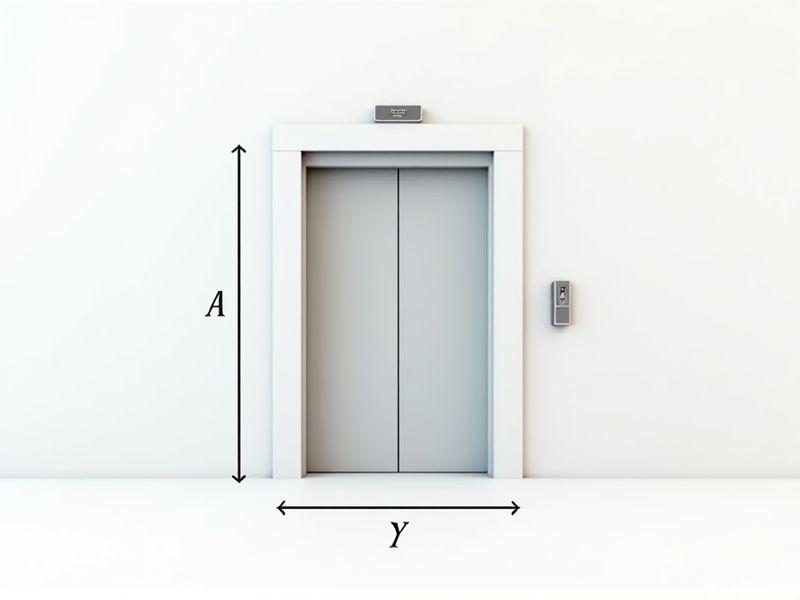
Standard dimensions for elevators can vary depending on the building's purpose and regional codes, but most passenger elevators in commercial or residential buildings typically range from 6 to 7 feet wide and 5 to 6 feet deep, with a ceiling height of about 8 feet. These interior dimensions provide enough space for 8 to 15 people, depending on the elevator's weight capacity. For wheelchair accessibility, the minimum recommended size is often 5 feet wide by 7 feet deep, ensuring compliant and comfortable entry and exit. Always review local codes and consult with elevator manufacturers, as requirements may differ for freight, hospital, or specialty elevators.
Cabin Dimensions
Cabin dimensions are a crucial factor in elevator design, with standard sizes typically ranging from 3 to 5 square meters for passenger cabins. For effective accessibility, the minimum clear internal cabin width is often set at 1,100 mm, allowing ample space for wheelchair users. The height usually measures around 2,200 mm, accommodating various user needs and ensuring a comfortable experience. Keeping cabin dimensions within these standards not only enhances user safety but also complies with building regulations across many regions.
Door Width
The standard door width for elevators is typically between 36 inches to 48 inches, allowing for easy access for passengers and mobility devices. A wider door width, such as the 48-inch option, accommodates individuals using wheelchairs or those with strollers, enhancing overall accessibility. Most commercial buildings comply with the Americans with Disabilities Act (ADA) guidelines, which recommend a minimum door opening width of 36 inches to ensure adequate maneuverability. When selecting an elevator, consider that a wider door not only improves accessibility but also adds value to your property by attracting a broader range of users.
Shaft Size
The standard shaft size for elevators typically ranges from 5 feet by 5 feet to 7 feet by 9 feet, accommodating various types of lifts such as passenger and freight elevators. Ensuring proper clearance, the minimum interior height of an elevator shaft is generally 8 feet, although local codes may specify different requirements. Your elevator installation may also need to consider the weight capacity, which can range from 1,000 pounds for standard passenger elevators to over 5,000 pounds for heavy-duty models. Compliance with regulations, such as the American Society of Mechanical Engineers (ASME) A17.1, is crucial for maintaining safety and performance in elevator designs.
Load Capacity
Load capacity is a critical standard for elevators, influencing their design and performance. Typically, residential elevators accommodate up to 1,000 pounds, while commercial units can support loads ranging from 2,500 to 5,000 pounds or more. The American Society of Mechanical Engineers (ASME) specifies these load ratings to ensure safety and efficiency in vertical transportation. Understanding the load capacity requirements for your building can enhance both functionality and compliance with industry regulations.
Overhead Clearance
Overhead clearance for elevators is a crucial factor that ensures safe and efficient operation. The minimum required overhead clearance typically ranges from 10 to 14 feet, depending on the elevator type and design standards. In commercial buildings, adhering to these specifications can enhance accessibility and meet regulatory compliance. Evaluating your building's architecture can help determine optimal overhead clearance, facilitating smooth installation and operation of the elevator system.
Pit Depth
Pit depth is a crucial standard in elevator design, typically ranging from 3 to 8 feet, depending on the elevator type and building requirements. A deeper pit enhances the safety and functionality of hydraulic elevators, providing necessary space for mechanisms and ensuring smooth operation. For traction elevators, a pit depth of at least 4 feet is recommended to accommodate counterweights and maintain optimal performance. Ensuring the correct pit depth not only complies with safety regulations but also contributes to the longevity of your elevator system.
Car Height
Elevator car height typically ranges between 80 inches (204 cm) to 120 inches (305 cm), depending on the model and intended use. Standard residential elevators often feature a car height of around 84 inches (213 cm) to accommodate users comfortably. Commercial elevators, designed for high traffic, may have larger car heights exceeding 96 inches (244 cm) to ensure accessibility for various equipment and larger groups of people. When selecting an elevator, consider your building's needs, as the appropriate car height can significantly enhance user experience and functionality.
Control Panel Height
The standard control panel height for elevators typically ranges from 38 to 54 inches above the finished floor, ensuring accessibility for all users, including those with disabilities. Adhering to the Americans with Disabilities Act (ADA) guidelines, a maximum height of 48 inches is often recommended for optimal usability. Control panels are designed with raised characters or braille for improved visibility and tactile navigation. Ensure your elevator complies with these height standards to enhance safety and usability for every passenger.
Lobby Dimensions
Elevator lobbies typically have a minimum dimension of 10 feet by 12 feet to ensure smooth passenger flow and accessibility. In high-rise buildings, these lobbies may expand to as much as 20 feet by 30 feet, accommodating larger volumes of traffic and providing space for amenities like seating or information kiosks. It's essential to maintain a clear vertical clearance of at least 10 feet to avoid any obstructions and to comply with safety regulations. Your elevator lobby should also incorporate accessibility features, including wide doorways and tactile signage, ensuring compliance with the Americans with Disabilities Act (ADA).
Handrail Placement
Elevators must adhere to specific standards regarding handrail placement to ensure user safety and accessibility. The recommended height for handrails ranges between 34 to 38 inches (86 to 97 cm) above the finished floor, providing support for individuals entering or exiting. Handrails should be securely mounted with a minimum clearance of 1.5 inches (3.8 cm) from the wall to avoid obstruction. Implementing proper handrail standards not only enhances the user experience but also complies with accessibility guidelines, ensuring that elevators are safe for everyone.
